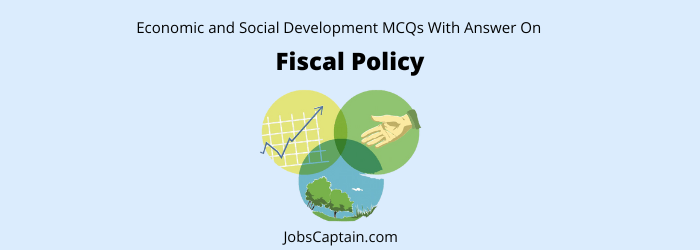
Take this fiscal policy quiz to test your knowledge of how the government uses taxes and spending to influence the economy! Fiscal policy is the use of government spending and taxation to influence the economy. If you’re preparing for an exam that covers fiscal policy, then check out this collection of practice questions.
| Return To | Economic and Social Development MCQ | |
Question 1: Fiscal Policy is concerned with ___________.
(A) the volume of currency that banks should put in the economy
(B) the policy regarding taxation and expenditure
(C) policy for regulating stock
(D) the policy for dealing with IMF
Question 2: Which one of the following is part of fiscal policy?
(A) Production policy
(B) Tax policy
(C) Foreign policy
(D) Interest rate policy
Question 3: Fiscal policy means ___________.
(A) policy relating to money and banking in a country
(B) policy relating to non-banking financial institutions
(C) policy relating to government spending, taxation and borrowing
(D) policy relating to financial matters of international trade
Question 4: Which one of the following is NOT the objective of the fiscal policy of government of India?
(A) Full employment
(B) Price stability
(C) Regulation of inter-state trade
(D) Economic growth
Question 5: In India, which one among the following formulates the fiscal policy?
(A) Planning Commission
(B) Finance Commission
(C) Finance Ministry
(D) Reserve Bank of India
Question 6: Which of the following economists, introduced fiscal policy as a tool to rectify the Great Depression of
1929-30?
(A) Prof. Keynes
(B) Prof. Pigou
(C) Prof. Marshall
(D) Prof. Crowther
Question 7: A change in fiscal policy affects the balance of payments through _________.
(A) Only the current account
(B) Only the capital account
(C) Both the current account and capital account
(D) Neither current account nor capital account
Question 8: Which one of the following was not stipulated in the Fisca Responsibility and Budget Management Act 2003?
(A) Elimination of revenue deficit by the end of the fiscal year 2007-08
(B) Non-borrowing by the Central Government from Reserve Bank of India except – under certain circumstances
(C) Elimination of primary deficit by the end of the fiscal year 2008-09
(D) Fixing government guarantees in any financial year as a percentage of GDP
Question 9: Fiscal Responsibility and Budget Management Act was enacted in India in the year _________.
(A) 2007
(B) 2005
(C) 2002
(D) 2003
Question 10: Which one of the following statements appropriately describes the ‘fiscal stimulus’?
(A) It is a massive investment by the government in manufacturing sector to ensure the supply of goods to meet the demand surge caused by rapid economic growth
(B) It is an intense affirmative action of the government to boost economic activity in the country
(C) It is government’s intensive action of financial institutions to ensure disbursement of loans to agriculture and allied sectors to promote greater food production and contain food inflation
(D) It is an extreme affirmative action by the government to pursue its policy of financial inclusion
Question 11: Globalisation does not include __________.
(A) reduction in import duties
(B) abolition of import licensing
(C) free flow of FDI
(D) disinvestment of Public Sector Equity
Question 12: Consider the following statements.
- The Fiscal Responsibility and Budget Management (FRBM) Review Committee Report has recommended a debt to GDP ratio of 60% for the general (combined) government by 2023, comprising 40% for the Central Government and 20% for the State Government.
- The Central Government has domestic liabilities of 21% of GDP as compared to that of 49% of GDP of the State
Government.
- As per the Constitution of India, it is mandatory for a State to take the Central Government’s consent for raising any loan if the former owes any outstanding liabilities to the latter.
Which of the statement(s) given above is/are correct?
(A) Only 1
(B) Only 2 and 3
(C) Only 1 and 3
(D) 1, 2 and 3
| Return To | Economic and Social Development MCQ | |
